Pumping station for a private home: how to choose and what to look for before buying
Remember how much time, effort, and sometimes nerves it takes to simply provide water to a country property. Try to transfer a considerable volume manually to the water collection points without getting tired.And if you still need to fill the containers for watering the garden, the swimming pool and the tanks in the bathhouse, then it is easier to abandon the idea altogether than to implement it. Is it true?
It’s a completely different matter if such a labor-intensive process is carried out by pumping equipment instead of you. Tireless “workers” will provide all facilities with water as quickly as possible. Therefore, a pumping station for your home or beloved dacha is simply necessary. And we will tell you in detail how to choose it in the next article.
The information we offer illuminates in great detail the nuances of the device and the principle of operation of the system. The criteria for choosing a unit and the most popular models are presented to your attention. The information we offer is supported by useful diagrams, photos and videos.
The content of the article:
Choosing the best option for water supply
A private source in a suburban area can fully provide water to a residential building, local area, vegetable garden, or garden.
To create an uninterrupted, well-functioning water supply system, it is necessary to think through the supply process, that is, select a pumping station to pump liquid from the source to the house or to other water collection points and lay communications.
There are three generally accepted methods for water transfer devices:
- pumping using a pump directly to the consumer;
- use of a storage tank and pump;
- application hydraulic accumulator and pump.
The pump connection diagram is considered the simplest, since water is supplied directly from the well to the place of use - a kitchen tap, watering hose, etc.
When choosing equipment for connection, you must carefully study its technical characteristics and ensure the availability of a power source. Frequent activation (if automation is provided, then every time the tap is opened) leads to the fact that the pump quickly fails.

A pump without additional equipment is good for small summer cottages that are visited during the warm season or visited occasionally, for example, on weekends.
The second option is distinguished by the presence of a storage tank - a tank installed in the upper part of the building (most often in the attic).
The advantage of this design is the water supply equal to the volume of the tank. Even during power outages, you can freely wash dishes or take a shower.
Disadvantages of this design:
- a necessary condition is the presence of an insulated attic of sufficient area to install the tank;
- The large size of the container is important, so you will have to strengthen the ceilings;
- In case of an accident, high-quality waterproofing should be done.
Sometimes additional costs are required to purchase a second pump. It is necessary to maintain certain pressure parameters.
The more mechanisms, the more complex the system and the higher the likelihood of failures during operation.
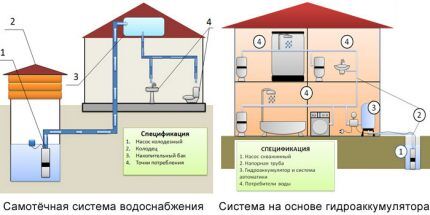
The third option is the most acceptable for those who constantly live outside the city and want to improve their home to the maximum.
The hydraulic accumulator provides the building and other consumer objects with the necessary amount of water, creating the required pressure. In addition, two most important principles for technology are observed - efficiency and high productivity.
The principle of the pumping station
The pumping station can be purchased ready-made or independently assembled from its component parts: a hydraulic accumulator tank, (submersible pump or surface type pump), pressure switch and automatic control unit.
Experts recommend choosing a ready-made pumping station, in which all elements are ideally suited to each other in terms of technical characteristics, material and size.
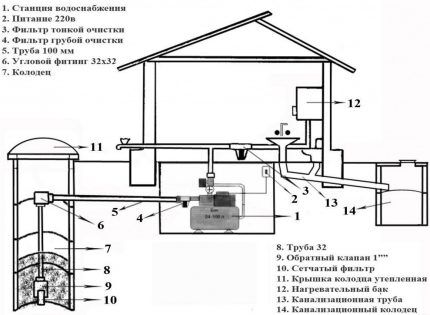
Submersible pump with filter and check valve can be replaced with a surface model - both options have their advantages.
The filter is necessary to protect communications from sand lying at the bottom and suspended impurities; a check valve prevents the outflow of water in the opposite direction when the unit automatically turns off.
The shutdown occurs by a signal from a pressure switch, which is activated when the pressure reaches its maximum level. As soon as there is less liquid in the accumulator tank, the pressure stabilizes, the mechanism turns on again and begins to pump water.
To operate the station, a 220 V power supply is required. The cross-section of the pipes must be selected so that water moves freely through the channels connecting the pumping equipment and points of consumption.
Powerful equipment is capable of providing water to a building in which a family of 5-6 people lives, and water points outside the house (in the garage, in the summer kitchen, in the garden or garden).
Selecting a model based on specific characteristics
The variety of models on the market is explained by the fact that the conditions for connection can be completely different: some require an option well pumping station (with a surface pump installed in a caisson), others need a submersible mechanism or a more powerful model with an ejector capable of pumping water from a well from a depth of 20-25 m.
When choosing pumping equipment in a store, the properties of the samples provided must be compared with individual requirements.
Calculation of pump performance
There are difficulties with calculating productivity, because many people do not know what to start from. In fact, for objective calculations, several factors should be considered.
For example, it is important to take into account the volume of drawdown of a well - a one-time water intake at zero flow rate, the rate of restoration of the volume of liquid in the source, the mode of active operation of the water supply system, etc.
To find out the average, data for 1 day is enough. This is possible due to the complete restoration of the volume of water in the well in 5-6 hours (the time when the liquid is not consumed at all).
The busiest “rush hours” are periods of time when there is active use of bathrooms or watering of a personal plot. They are the ones most suitable for the objectivity of calculations.

Let's assume that the well has a flow rate of 200 l, and the drawdown volume is 50 l. If three family members take a bath (200 l each) sequentially, and we need water to flow freely to other water collection points, the productivity should not be lower than 300 l/h.
Sometimes the calculation is made based on the sum of water consumption by all family members or by calculating the maximum water use - peak consumption.
It is assumed that all water points are used simultaneously, the average flow of which is:
- washbasin mixer – 0.1 l/s;
- kitchen mixer – 0.15 m/s;
- drain tank - 0.1 m/s;
- shower – 0.25 l/s;
- washing machine – 0.3 l/s.
The maximum possible productivity is considered to be 800-1000 l/h (or more), but not every well has such a water supply and high recovery rate.
Maximum water intake depth
To find out this parameter, you need to know exactly the dimensions of the well (well) and measure the distance from the installation site of the accumulator to the source.
The basic value is taken to be the height from the water surface to the axis of the pump installed near the well or well. If the station is located at any distance, for example, in the basement of a house, then the horizontal section must also be taken into account.

There is an allowance for error due to the resistance exerted by pipes, check valves and filters. This means that you need to add about 15% more to the amount received.
By the way, the resistance of stainless steel pipes, which is used less and less, is much higher than that of plastic communications.
The vertical arrangement of pipes relates to the horizontal in a ratio of 1:10. For example, the distance to the installation site of the hydraulic accumulator is 20 m, the depth of the well to the water surface is 8 m, therefore, equipment with a minimum intake depth of 8 m + 20 m is required: 10 = 10 m
Hydraulic accumulator tank volume
When choosing a pumping station for a private home, do not forget to inquire about the volume of the hydraulic accumulator, since the full supply of water depends on the size of the tank. The larger the tank, the more space the equipment takes up and the more expensive the entire installation costs.
It is believed that large tanks have less frequent on/off cycles, which increases their service life significantly.
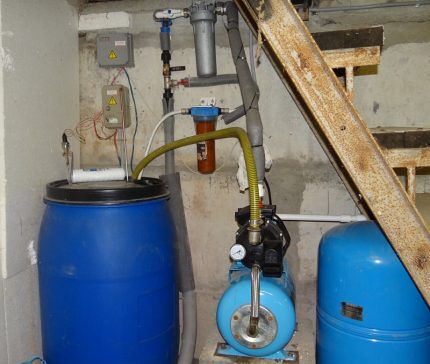
For a single resident or a couple, a volume of 24-30 liters is sufficient. A small container is also appropriate when the need for water supply occurs periodically, for example, on weekends.
A volume of 50 liters is an average capacity, suitable for serving a group or family of 3-5 people permanently living in a country house. For housing that unites more than five people under its roof, you should purchase equipment with a 100-liter tank.
It is irrational to buy containers smaller than 24 liters, as they wear out quickly and, accordingly, have a short service life.
Water pressure in the system
The functioning of the system will be complete and comfortable only if there is sufficient water pressure at each point of water consumption. It means that network pressure ensures uninterrupted, correct supply.
For example, for a kitchen faucet, a pressure of 1/1.5 atmospheres is sufficient, which equals 10/15 m of water column. More serious equipment requires increased parameters.
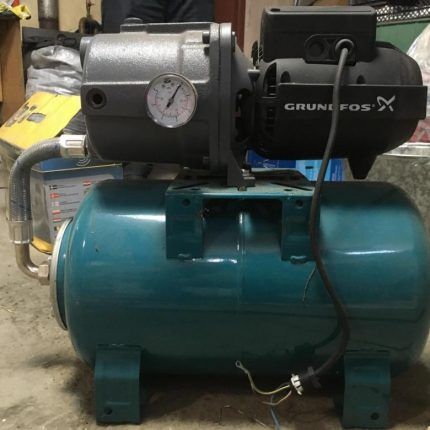
The water pressure value can be found in the instructions. Units with a maximum head of 45-50 m can be used equally well both in country cottages and in small businesses.
They have increased productivity (up to 4500 l/h) and are often equipped with an additional storage tank
Power and voltage
Installation power and supply voltage are required for correct pumping station connections. The standard power supply voltage - 220 V - is typical for most household pumping stations, since single-phase AC networks are much more common.
A voltage of 380 V is necessary for high-performance operation of equipment on an industrial scale, and in the residential sector it can only be found in multi-story buildings.
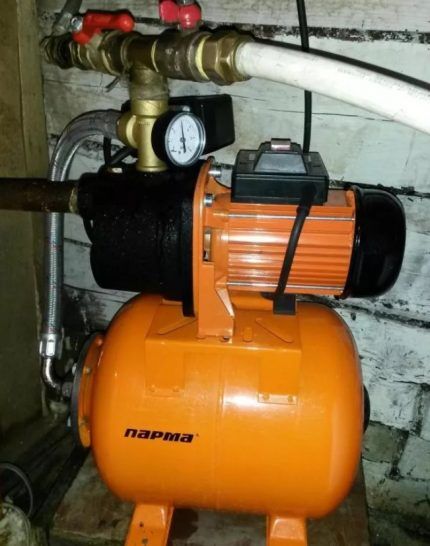
The power of household installations with a hydraulic accumulator is from 600 to 2000 W. It influences the choice of protective devices and power cable. If overheating, short circuit, or dry running occurs, modern models automatically turn off.
Unit type and functionality
Models from the same manufacturer, and even more so from different brands, differ in appearance and potential capabilities.
Suppose pressure switch, which ensures timely shutdown of equipment, can be connected in two ways: using a flexible hose or directly to the housing. This does not change the principle of operation, only the external design is different.
More serious differences relate to the type of pump - the main working part. The most common are self-priming devices, which easily tolerate light contamination of water and the presence of air in the pipes.
The main disadvantage of units of this type is the limited height of liquid lifting from the source (from 6 to 9 m). Another small drawback is the high noise level, but this can be solved by installing the pump in a separate room.
Some models are equipped with an ejector, built-in or external. The built-in one allows you to increase the depth of water supply to 15 m, while the external one is capable of extracting liquid from a depth of 45-50 m. The disadvantage is reduced efficiency and noise.
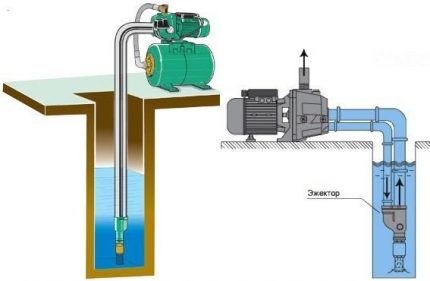
For wells and boreholes up to 10 m deep, quieter multi-stage devices are used. They are more expensive and more complex in design, have powerful pressure and a high degree of productivity. The main external difference between units of this type is the elongated shape of the working chamber, which accommodates several wheels instead of one.
For summer cottages with a small house and a shallow well (6-7 m), vortex pumping stations are suitable. They are characterized by high pressure (which allows them to be used to increase pressure in the system), quiet operation, efficiency, but low productivity
Reputation of the equipment manufacturer
When choosing this or that model, you definitely pay attention to the manufacturer and try to remember how reliable its products are. This is the right approach, because the life of a pumping station is measured in years, and there is no point in purchasing a low-quality one.
Nowadays, almost all companies involved in the production of pumping equipment are focused on the interests of the consumer and have in their arsenal a whole set of models that differ in technical characteristics.
Well-known domestic brands Gilex, Zubr, Vikhr compete with the Italians Marina, Ergus, Pedrollo in terms of the number of lines presented.
However, the palm belongs to the German brands Gardena, Metabo, Wilo SE, Kärcher, Grundfos, which have always been distinguished by excellent quality and maximum functionality.
All brands that have taken root in Russia have adapted their equipment to local climatic conditions. Let's consider the rating of popular models so that the idea of pumping devices becomes more complete.
Rating of pumping stations for a private home
KARCHER BP 5 Home
Quiet, powerful station of unsurpassed German quality
Karcher BP 5 is an excellent model for an individual water supply system. Build quality, ease of use and ease of installation have made this model popular among users.
Brief overview of characteristics:
- type – surface pumping station
- head – 50 m
- tank volume – 24 l
- mains voltage – 220/230 V
- thread diameter – 1"
- pump installation type – horizontal
- weight - 14.72 kg
The station is designed for pumping clean water. Installation is permitted in boiler rooms or pavilions specially built for it.
Karcher brand pumping equipment is distinguished by its neat appearance, ergonomics and ease of use. Almost all models are equipped with handles for moving.
- Overheating and dry running protection
- Built-in on/off system
- Operating status monitoring and indication system
- Stainless steel flange and shaft
- Check valve included
- Short power cord length (1 m)
- No on/off button
PATRIOT R 1200/24 INOX
Powerful station for pumping clean water
PATRIOT R 1200/24 INOX – model for pumping clean water with a stainless steel pump part.
Brief overview of characteristics:
- type – surface pumping station
- head – 30 m
- tank volume – 24 l
- mains voltage – 220/230 V
- thread diameter – 1"
- pump installation type – horizontal
- weight - 14.4 kg
The case, made of stainless steel, prevents the penetration of atmospheric water. The unit can be operated temporarily in an open area in high humidity conditions.
For permanent installation outdoors, it is recommended to install a box.
The fairly powerful Patriot 1200/24 INOX unit is an excellent option for servicing wells and wells located in close proximity to a residential building.
- Durable and waterproof metal housing
- Capacious tank
- Excellent performance
- Pressure switch
- No dry running protection
Bison ZNAS-1200-S
Production station for providing water to private homes
Zubr ZNAS-1200-S is an automatic pumping station suitable for providing water to a small country house.
Brief overview of characteristics:
- type – surface pumping station
- head – 50 m
- tank volume – 20 l
- mains voltage – 220/230 V
- thread diameter – 1"
- pump installation type – horizontal
- weight - 13 kg
The pumping unit is designed to interrupt and start work ten times or more per day. The model is automated and maintains operating pressure parameters in the system.
The high-performance model Zubr ZNAS-1200-S is capable of lifting water to a great height, therefore it is often used to install water supply systems for two-story mansions.
- Raises water to the second floor
- Equipped with a check valve
- There is protection against overheating
- There may be problems with attaching the motor to the tank
- After 2 years the gasket may need to be replaced
Gilex Jumbo 50/28 Ch-18
Compact and high-performance pump at an affordable price
Gilex Jumbo 50/28 Ch-18 is a high quality device made from especially durable materials.
Brief overview of characteristics:
- type – surface pumping station
- head – 28 m
- tank volume – 18 l
- mains voltage – 220/230 V
- thread diameter – 1"
- pump installation type – horizontal
- weight - 15.1 kg
In addition to drawing water from underground sources, the station is capable of pumping water from open reservoirs. Equipped with automatic control devices, it can be customized to the specific needs of home owners.
The Gilex Jumbo 50/28 Ch-18 pumping device does not have high performance, but it is convenient to use and is equipped with an ejector and a reliable automation kit.
- Compact station dimensions
- Inexpensive price tag
- Availability of spare parts
- Reliable cast iron body
- Automation on the body
- Tank volume is too small
- You cannot set a pressure higher than 2.8 atm
AL-KO HW 4000 FCS Comfort
Easy to maintain and quiet pumping equipment
The AL-KO HW 4000 FCS Comfort station is designed to work with clean water. Can be used to automate the water supply system of a private home or cottage.
Brief overview of characteristics:
- type – surface pumping station
- head – 45 m
- tank volume – 17 l
- mains voltage – 220/230 V
- thread diameter – 1"
- pump installation type – horizontal
- weight - 17.9 kg
This pumping station is capable of providing the required volume of water to several water intake points - with the AL-KO HW 4000 FCS Comfort you can water the beds, use the shower and washing machine.
Thanks to its quiet operation and small dimensions, this equipment can be installed even in a residential area.
- Protection against dry running and overheating
- Electronic pressure switch
- There is practically no noise during operation
- Built-in XXL filter and check valve
- Difficult to buy spare parts
- Small hydraulic tank volume
Marina CAM 198/60
Powerful pumping station capable of operating for a long time in automatic mode without interruption
Marina-Speroni CAM 198/60 is a device with a powerful engine and protection against dry running. It is used for pumping water from open and underground sources.
Brief overview of characteristics:
- type – surface pumping station
- head – 60 m
- tank volume – 60 l
- mains voltage – 220/230 V
- thread diameter – 1"
- pump installation type – horizontal
- weight - 28 kg
Fully automated, so it does not require constant participation in the work process of home owners. There is a system for adjusting the pressure parameters required for an uninterrupted supply of water.
The powerful Marina-Speroni CAM 198/60 installation is protected from overloads and is capable of operating for a long time without interruption, ideal for suburban water supply.
- High quality build
- Excellent pressure retention up to 3.0 atm
- When used correctly it works without problems
- Capacious tank
- Very noisy
- High price tag
VORTEX ASV-1200/50
Inexpensive option for a household pumping station with a spacious hydraulic tank
Powerful pump with ejector, capable of operating in automatic mode. It easily maintains the required pressure in the network, turning on and off as necessary.
Brief overview of characteristics:
- type – surface pumping station
- head – 40 m
- tank volume – 50 l
- mains voltage – 220/230 V
- thread diameter – 1"
- pump installation type – horizontal
- weight - 18.2 kg
This pumping station model is capable of providing individual water supply to a country house. And also, thanks to good pressure, it allows you not to spend a lot of time watering the beds.
The capacious 50-liter tank of the VORTEX ASV-1200/50 station is capable of providing uninterrupted water supply to a small farm.
Among the negative aspects, some owners note that there are defective copies, and this threatens breakdowns in the first 2 months of operation. Therefore, when purchasing, it is important to carefully inspect the equipment.
- Good power - enough for household needs and watering the garden
- Great price
- Easy to connect
- There are no special requirements for the purity of pumped water
- Problems with purchasing spare parts
- Pressure switch sticks
- It is noticeably noisy during operation
GARDENA 4000/5 eco Comfort
Quiet station for organizing a country water supply with a mode of reduced electricity consumption
GARDENA 4000/5 eco Comfort is easy to install and use. Copes well with water supply from wells and boreholes.
Brief overview of characteristics:
- type – surface pumping station
- head – 45 m
- tank volume – 24 l
- mains voltage – 220/230 V
- thread diameter – 1"
- pump installation type – horizontal
- weight - 15 kg
This pumping station has an eco mode, when turned on, the equipment consumes a minimum of electricity.
There is practically no noise during operation. Requires minimal attention from the owner - the filter will have to be changed as soon as it gets dirty.
GARDENA 4000/5 eco Comfort is ideal for installing water supply in a country house, and its power is enough to supply water both to the bathhouse and to the house - to service the tap and even the washing machine.
- Solid build and good quality plastic
- Dry running protection
- Built-in overheat protection
- Eco mode to save electricity
- Difficult to find spare parts
- Incomprehensible algorithm for triggering protection
- The price is high for such characteristics
Quattro Elementi Automatico 801
Simple and compact station to meet minimal water needs
The Quattro Elementi Automatico 801 station is well assembled - nothing creaks or wobbles. And the quality of the plastic is quite consistent with the price set for this equipment.
Brief overview of characteristics:
- type – surface pumping station
- head – 40 m
- tank volume – 20 l
- mains voltage – 220/230 V
- thread diameter – 1"
- pump installation type – horizontal
- weight - 12.6 kg
This pumping equipment copes well with supplying water to a country house - in 5 minutes it can pump up a storage tank to 100 liters. Due to its low power, it produces minimal noise during operation.
The kit does not include a filter or check valve, but everything necessary is included in the manufacturer’s assortment. Therefore, you can purchase them immediately when purchasing the station. Many owners of Quattro Elementi Automatico 801 recommend immediately purchasing and installing a filter and check valve along with the station.
- Low cost
- Works quietly
- Threaded brass inserts in pump housing
- The quality of the plastic matches the price
- There is no built-in filter and you need to purchase a non-return valve
- Carrying handle may be missing
- Contacts turn sour
Caliber SVD-850P
A suitable option for summer residents at an affordable price
The SVD-850P caliber is used to supply water from wells, swimming pools, and water intake structures with a depth of no more than 8 m.
Brief overview of characteristics:
- type – surface pumping station
- head – 40 m
- tank volume – 20 l
- mains voltage – 220/230 V
- thread diameter – 1"
- pump installation type – horizontal
- weight - 10.9 kg
The plastic housing of the pump requires protection from UV radiation and other atmospheric aggression. In addition to standard consumers, the station can serve water heating units, irrigation and watering systems, dishwashers and washing units.
Pumps and pumping stations of the Caliber brand are the favorite models of summer residents who are engaged in the seasonal cultivation of vegetable gardens and garden crops.
- Affordable price
- Excellent power
- Pressure builds up quickly
- Sufficient tank volume
- Compact dimensions
- No check valve
- The rubber ring between the engine and the housing does not fit tightly
- Low quality plastic parts
- Pressure switch sticks in "on" state
As you can see, there can be significant differences in performance, lift height and power between different models.
We also have an article on our website with a rating the best pumping stations for the dacha. Please go ahead and see which option is best for you.
Conclusions and useful video on the topic
Useful educational video reviews will help you better understand the purpose, technical characteristics and selection of pumping stations.
Detailed informative video about modern models from the manufacturer Aurora:
All about the technical characteristics of household pumping equipment:
If you own a private home, you will definitely need modern pumping equipment. Before purchasing, carefully study the technical data of the automatic pumping station and find out whether it is suitable for your home.
You can install the unit yourself, but only experienced professionals can take into account all the installation tricks.
Do you use one of the pump models discussed in this article? Please share your impressions with us!
Or do you have questions about choosing equipment for your country water supply? Please ask your questions in the comments to this article.




To be honest, I didn’t risk building a pumping station on my own - I still don’t have enough experience in this matter. I chose a ready-made option with a storage tank.I placed it in the attic (it doesn’t freeze in winter, so it’s not scary to put it there). The pumping station was taken by Marina-Speroni - although it is not cheap, it is powerful. I collect water from a well next to my house. Works well.
I don’t understand what an injector is (no), and what does the venturi tube installed in the pump housing refer to?
Hello. Inside the ejector unit there is a Venturi tube, which provides a self-priming effect. Roughly speaking, this is a tube with a narrowing, entering which water creates an area of low pressure, which ensures water suction.